FFmpeg is indeed a powerful video encoder/decoder tool¹. It operates in the command line, as opposed to using a GUI. Command line is that black window you find by typing [windows+r], then cmd in the popup field and hitting enter. This is also called «command prompt». Once setup, you enter FFmpeg commands in one of these windows to use it.
Here are the basic steps to «install» and use it:
Installation
- Download the latest FFmpeg build, courtesy of gyan.dev.
- Create a folder on your computer to unpack the zip file. This folder will be your «installation» folder. I chose
C:Program Filesffmpeg. This is a good idea because you will treat this like a regular program. Unpack the zip file into this folder. - The folder should now contain a number of other folders, including one titled
binwhereffmpeg.exeis saved. We’re not done yet. Double clicking that file does nothing. Remember, this is a command line program. It runs incmd. - Before you can use
ffmpeg.exeincmdyou have to tell your computer where it can find it. You need to add a new system path. First, right click This PC (Windows 10) or Computer (Windows 7) then clickProperties > Advanced System Settings > Advanced tab > Environment Variables. - In the Environment Variables window, click the «Path» row under the «Variable» column, then click Edit
- The «Edit environment variable» window looks different for Windows 10 and 7. In Windows 10 click New then paste the path to the folder that you created earlier where
ffmpeg.exeis saved. For this example, that isC:Program Filesffmpegbin
In Windows 7 all the variables are listed in a single string, separated by a semicolon. Simply go the the end of the string, type a semicolon (;), then paste in the path.
- Click Ok on all the windows we just opened up. Just to be sure, reboot your computer before trying any commands.
FFmpeg is now «installed». The Command Prompt will now recognize FFmpeg commands and will attempt to run them. (If you are still having issues with Command Prompt not recognizing FFmpeg try running CMD as an admin. Alternatively, you can use windows powershell instead of cmd. If it still does not work double check to make sure each step was followed to completion.)
Alternative installation methods
I’ve not tried these myself, but they probably work, and they’re easy to do. However, you can accidentally mess up important things if you’re not careful.
First, if you open cmd with administrator privileges, you can run setx /m PATH "C:ffmpegbin;%PATH%", and change C:ffmpegbin to your path to FFmpeg. This uses cmd to do all the gui steps listed above. Easy peasy.
Second, user K7AAY reports that you can simply drop the FFmpeg executables in C:WindowsSystem32 and run them from there without having to define the path variable because that path is already defined.
Updating FFmpeg
To update FFmpeg, just revisit the download page in step 1 above and download the zip file. Unpack the files and copy them over the old files in the folder you created in step 2.
Using FFmpeg
Using FFmpeg requires that you open a command prompt window, then type FFmpeg specific commands. Here is a typical FFmpeg command:
ffmpeg -i video.mp4 -vn -ar 44100 -ac 1 -b:a 32k -f mp3 audio.mp3
This command has four parts:
ffmpeg— This command tells cmd that we want to run FFmpeg commands. cmd will first look forffmpeg.exein one of the folders from step 6 in the Installation section. If it is found, it will attempt to run the command.-i video.mp4— This is an input file. We are going to be doing work on this file.-vn -ar 44100 -ac 1 -b:a 32k -f mp3— These are the «arguments». These characters are like mini commands that specify exactly what we want to do. In this case, it is saying create an mp3 file from the input source.
-vn— Leave out the video stream-ar 44100— Specifies audio resolution in hertz.-ac 1— Audio channels, only 1. This is effectively «make mono».-b:a 32k— Audio bitrate, set to 32 kbps.-f mp3— Force to MP3 conversion. Without this command, FFmpeg attempts to interpret what you want based on the extension you use in the output file name.
audio.mp3— This is the output file.
As you can probably guess, this short command makes an MP3 audio file from an MP4 file.
To run this command, assuming you have an MP4 file to try this on, follow these steps:
- Hit the Windows key + r.
- Type
cmdthen enter. - Change the path to where the file is that you want to work on. Type
cd [path]. It should look something likecd C:UsersnameDesktop. - Now type the FFmpeg command with the name of your input file. The command will run with some feedback. When it’s done, cmd will be available for more commands.
This is the basic way to use FFmpeg. The commands can get far more complicated, but that’s only because the program has so much power. Using the FFmpeg documentation, you can learn all the commands and create some very powerful scripts. After that, you can save these scripts into a .bat file so that you just have to double click a file instead of type out the whole command each time. For example, this answer contains a script that will create MP3’s from all the MP4’s in a folder. Then we would be combining the power of FFmpeg with the power of cmd, and that’s a nice place to be when you have to do professional quality video/audio encoding on mountains of files.
- As a point if technical accuracy, FFmpeg is itself not an encoder or decoder. FFmpeg is a multimedia framework which can process almost all common and many uncommon media formats. It has thousands of to capture, decode, encode, modify, combine, and stream media, and it can make use of dozens of external libraries to do even more. Gyan.dev provides a succinct description.
Download Article
Download Article
FFmpeg is an open-source media tool you can use to convert any video format into the one you need. The tool is command-line only, which means it doesn’t have a graphical, clickable interface. If you’re used to installing regular graphical Windows programs, installing FFmpeg may seem complicated at first—but don’t worry, it’s actually pretty easy! This wikiHow teaches you the simplest way to install FFmpeg on your Windows PC.
Steps
-
1
Go to https://ffmpeg.org/download.html. This brings you to a page containing the latest FFmpeg install packages and binary files.
- If you don’t have an app that can decompress files ending with the .7z file extension, such as WinRAR or 7Zip, you must install one before you can continue.
-
2
Click the Windows logo. It’s the blue square with a white window inside.
Advertisement
-
3
Click Windows builds from gyan.dev. This takes you to a page that contains FFmpeg builds specifically for Windows that contains all of the hardware libraries you could possibly need.
- If you prefer, you could click Windows builds by BtbN instead, which is another Windows build of FFmpeg. There are a variety of builds available from different websites—the official FFmpeg website may add more as they become available.
-
4
Scroll down to the «git» section. It’s about halfway down the page between the set of green boxes and the «release» sections.
-
5
-
6
Extract the downloaded file. Here’s how:
- Right-click the Windows/Start button and select File Explorer.
- Click the Downloads folder in the left panel (you may have to click This PC first to find it).
- Right-click ffmpeg-*-git-*full_build.7z (the file name will vary depending on the current release).
- Select Extract Here and wait for the files to extract. This creates a new folder with the same name as the .7z file.
-
7
Rename the extracted folder to FFmpeg. To do this, just right-click the folder, type FFmpeg, and press the Enter key.
-
8
Click the FFmpeg folder once and press Control+X. This «cuts» the folder from the Downloads folder so you can paste it into the root of your hard drive.
-
9
Click This PC in File Explorer. It’s the computer icon in the left panel.
-
10
Double-click your hard drive. It’s usually called «Windows (C:)» or «Local Disk (C:)» but the name and drive letter may vary.
-
11
Right-click a blank area of the right panel and select Paste. This moves the folder to the root of your hard drive.
-
12
Open the system environment variables control panel. Here’s how:
- Press Windows key + S to open the search bar.
- Type system variables into the search bar.
- Click Edit the system environment variables in the search results.
- Click the Environment variables button in the bottom-right area of the window.
-
13
Select the Path variable under «User variables for (your name)» and click Edit. A list of paths will appear.
-
14
Add the FFmpeg binary directory to the path. This will allow you to easily run FFmpeg commands at the command prompt without having to type out the full path to FFmpeg. Here’s how:
- Click the New button to open a new blank line below the bottom-most path.
- Type C:ffmpegbin. Or, if you placed the FFmpeg folder on a different drive or in a different folder, replace this path with that location instead (remember to leave bin at the end).
- Click OK. Now you’ll see the FFmpeg path and the end of the «Path» variable in the upper portion of the window.
-
15
Click OK to save your changes. You’ve now installed FFmpeg and set the proper environment variables. To confirm that FFmpeg is working, open the command prompt and run this command to see the version number: ffmpeg -version
Advertisement
Add New Question
-
Question
How can I watch HEVC videos?
The newest version of VLC can play HEVC. FFplay, which comes with FFmpeg, can also play them.
-
Question
What versions of Windows does FFmpeg work with?
Windows 7 or above, MacOS 10.x.x.x or above.
-
Question
Why is ‘ffmpeg-version’ not recognized as an internal or external command, operable program or batch file?
Insert a space between «ffmpeg» and «-version»; -version is a switch on the ffmpeg command/program.
See more answers
Ask a Question
200 characters left
Include your email address to get a message when this question is answered.
Submit
Advertisement
Thanks for submitting a tip for review!
-
FFmpeg is a command line-only program, which means that you can only use it in Command Prompt. This may prove difficult for users who aren’t familiar with Command Prompt.
-
You must be on an administrator account in order to install FFmpeg.
Advertisement
About This Article
Article SummaryX
1. Download FFmpeg from https://www.gyan.dev/ffmpeg/builds/ffmpeg-git-full.7z.
2. Extract the file.
3. Rename the extracted folder to «FFmpeg.»
4. Move the «FFmpeg» folder to the root of your hard drive.
5. Right-click the Start menu and select Command prompt (Admin).
6. Run this command: setx /m PATH «C:FFmpegbin;%PATH%»
Did this summary help you?
Thanks to all authors for creating a page that has been read 1,440,596 times.
Is this article up to date?
Introduction
FFmpeg is a command-line audio and video converter available for Linux, macOS, and Windows. This open-source tool helps users manipulate multimedia content and offers free access to several audio and video libraries.
Even though FFmpeg doesn’t have a clickable GUI, the installation process is straightforward.
In this guide, you will learn how to install FFmpeg on Windows in four simple steps.
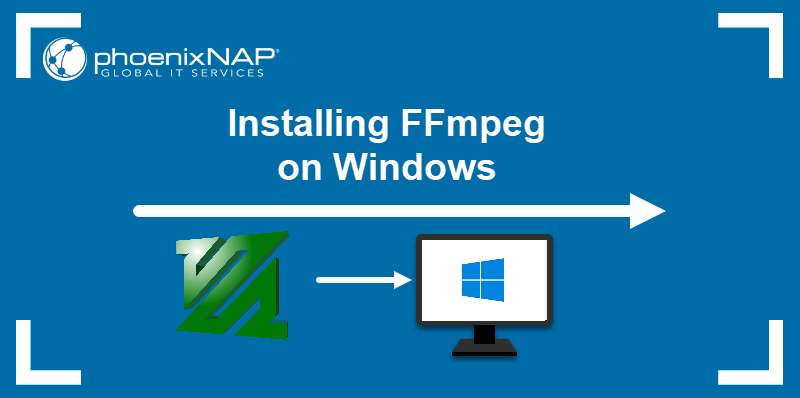
Prerequisites
- A system running Windows (This tutorial uses Windows 10).
- A file archiver (This guide uses 7-Zip).
- Command Prompt or Windows PowerShell access.
- Administrator privileges.
How To Install FFmpeg on Windows
Installing FFmpeg on Windows requires adding the utility to the Windows PATH. Additionally, users can manually navigate to the folder containing the executable and run the program. However, the process is time-consuming and impractical.
A straightforward way to work with FFmpeg is to add it to PATH by editing Windows environment variables. Therefore, Windows knows where to look for the executable. Users can run FFmpeg directly from the command line without typing in the full path to the app’s folder.
Step 1: Download FFmpeg for Windows
Visit the FFmpeg download page. The More downloading options section has FFmpeg packages and executable files for Linux, Windows, and Mac. To get the Windows version:
1. Hover over the Windows logo and click the Windows builds from gyan.dev link. A new page opens.
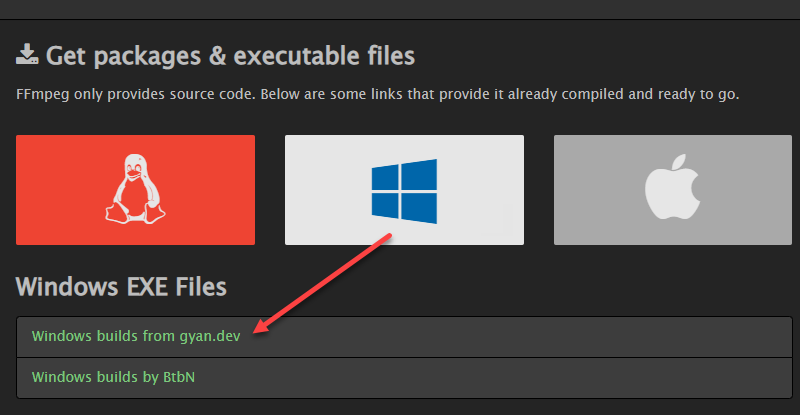
2. In the git master builds section, look for the latest version of the FFmpeg build. Click the ffmpeg-git-full-7z link to download the full build since that version has the most up-to-date libraries.
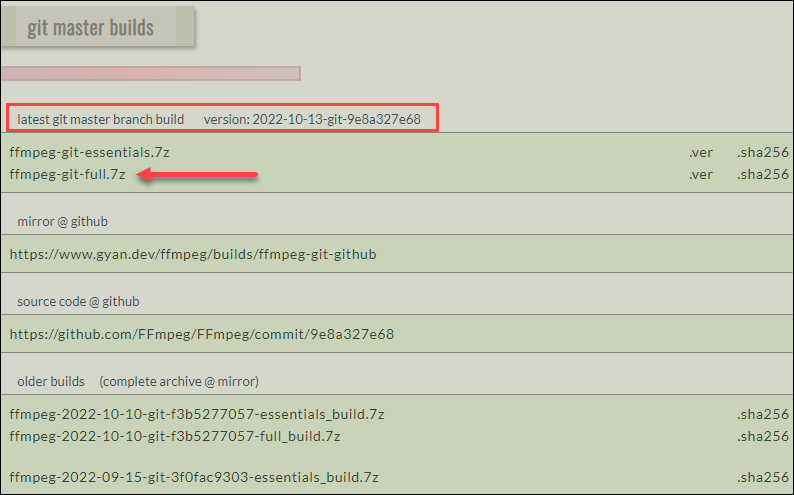
3. Choose the download location and save the file if the download does not start automatically.
Note: This guide uses the Windows build from gyan.dev. Other builds are available for download, like the one by BtbN. No official documentation confirms any significant differences between different builds.
Step 2: Extract the Downloaded Files
Once downloaded, extract the contents:
1. Locate the downloaded file. The default location is the Downloads folder.
2. Right-click the file and hover over 7-Zip (or another file archiver of choice).
3. From the archiver submenu, choose Extract here. Wait for a few seconds for the extracting process to complete.
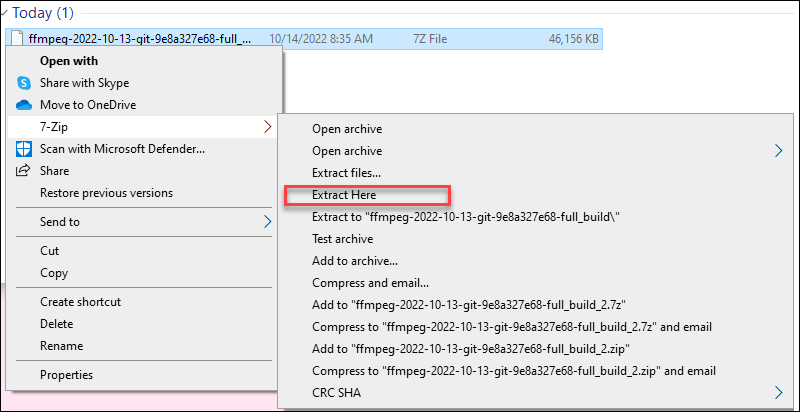
5. Rename the extracted folder to ffmpeg.

6. Move the folder to the root of the C drive or the folder of your choice.

Step 3: Add FFmpeg to PATH
Set Windows environment variables to add FFmpeg to the PATH. Follow these steps:
1. Type system variables into the search bar and click the Edit the system environment variables option.
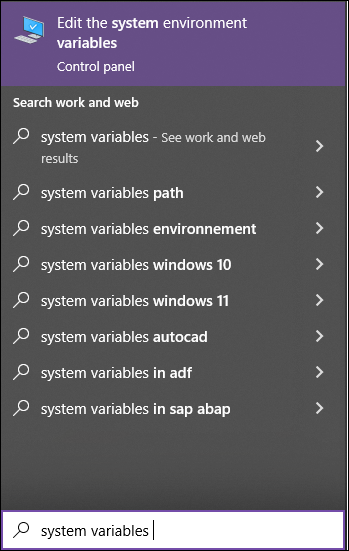
2. Under the User variables section, select Path and click the Edit button.

3. Choose New from the side menu.
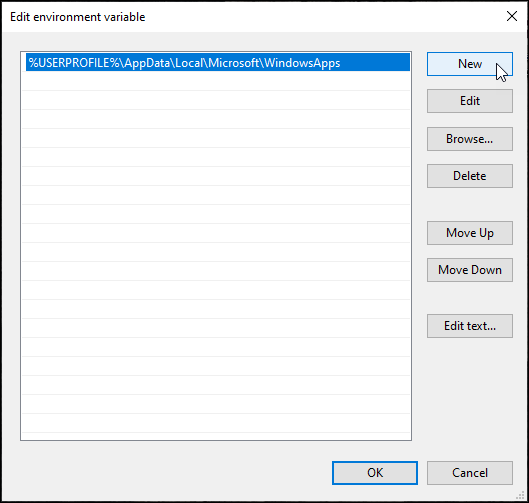
4. Add C:ffmpegbin to the empty field and confirm changes with OK.
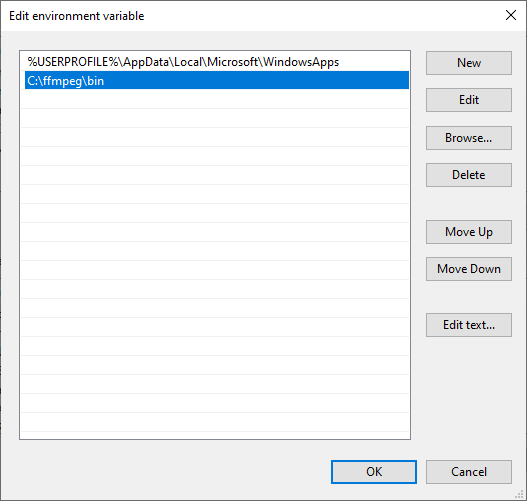
The change in the Path variable line confirms the FFmpeg is added to PATH.
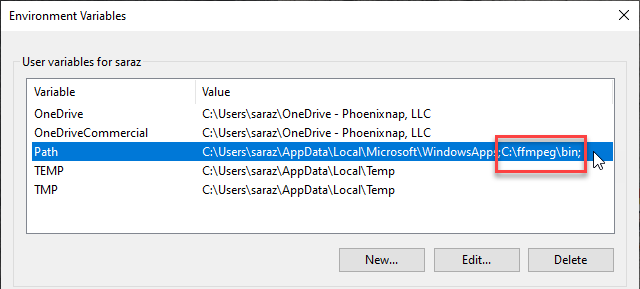
Note: If you stored FFmpeg in a folder other than the C drive, use that path accordingly.
Step 4: Verify FFmpeg PATH
To verify the FFmpeg is correctly added to the Windows PATH, open the Command Prompt or PowerShell and run:
ffmpegThe output confirms the installation:

Conclusion
This article provided an easy step-by-step guide on installing FFmpeg on Windows.
For more tutorials refer to our article and learn how to install FFmpeg on MacOS.
Next, learn how to change or reset the administrator password on the Windows server.
FFmpeg is a popular software for processing, converting, or manipulating video and audio files. The program is used for endless things like rotating videos, scaling videos, extracting information about videos, and many others. It is an open-source program that is simply awesome for video scaling, format transcoding, decoding, encoding, demuxing, streaming, filtering, converting audio files, recording live audio/video, handling video and other multimedia files. This multimedia framework is designed for command-line-based processing of multimedia files, and you can make basic edits with single-line commands.
While the program is simple to use, accessing FFmpeg to execute commands is a little confusing. Installing and using FFmpeg can take a lot of time as you need to manually open the FFmpeg folder within the command prompt or Power Shell terminal to access the FFmpeg executive file to execute relevant commands for basic editing. If you are stuck with installing and using FFmpeg on your machine, you are in the right place.
To make things simple, all you have to do is install FFmpeg and add the FFmpeg program to the Windows path using Environment variables. This way you can directly access FFmpeg from a Command prompt or Power Shell in any directory. In this article, we explain how to install FFmpeg on Windows in order to access FFmpeg directly from Command Prompt or PowerShell
Get the latest FFmpeg build from the official website here. You can either download the 32-bit version or the 64-bit version that suits your system. Click the Download Build button to start downloading.
The program doesn’t work directly on Windows 10. You need to add a program to the system path using Environment Variables.
So navigate to the downloaded folder where the FFmpeg zip file is a store. Right-click on the Zip folder and click extract from the drop-down menu.
Select the folder or drive where you want to extract.
Next, rename the extracted folder. To rename the folder, right-click on a folder and click Rename from the drop-down menu with title FFmpeg-20180424-d9706f7-win64-static to FFmpeg.
Copy the FFmpeg folder and navigate to C drive. Paste the folder to the root of C drive.
Once done, the next step is to enable FFmpeg using Command Prompt.
Add FFmpeg to Windows path using Environment variables
To use FFmpeg in Command Prompt, you need first to add the bin folder containing the FFmpeg executable file to your Windows path
In the Windows search menu, type Edit the system environment variables and click Enter. This will open the system properties window.
Navigate to Advanced button and click Environment Variables at the bottom of the window.
In the Environment Variables window, Select the variable Path and click Edit to change the Path variable.
Click New and type the path of FFmpeg folder “C:ffmpegbin” and click OK.
Type the path directory according to the drive or folder where you have placed FFmpeg folder.
Once done, the path gets added to the Environment variables. Click OK to apply changes.
Verify FFmpeg path in Command Prompt
Launch Command Prompt and type the command FFmpeg in the command prompt terminal and hit Enter.
If the FFmpeg is added properly to Windows Path, the command prompt will display the details about FFmpeg like its version number, configuration, etc.
If you weren’t successful, it only means that your command prompt did not recognize the commands. Cross-check to see if you have added the FFmpeg folder to the system path properly.
Read: Fix Audacity FFmpeg error on Windows PC.
That’s all!
Did you receive a video with those annoying black bars on the side? Do you wonder how you could change the orientation and remove those black bars? Or maybe you want to create a montage of your favorite pictures and make a music video. You can do all that for free when you install FFmpeg.
Not a reader? Watch this related video tutorial!
Not seeing the video? Make sure your ad blocker is disabled.
In this guide, you will learn to install FFmpeg and how to use it by following many examples. By the end, you’ll have acquired the foundation to start converting and altering media files!
Prerequisites
This tutorial will be a hands-on demonstration. If you’d like to follow along, be sure you have the following.
- You’ll need a computer running on a compatible operating system, such as Windows, Linux (RHEL-based, Debian-based, or Ubuntu-based), and macOS. This tutorial will be using Ubuntu 20.04, Windows 10, and macOS Big Sur for the installation.
While the installation method varies, FFmpeg usage should be the same across different operating systems.
- Your computer must have at least 4GB of RAM and a two-core CPU. Multimedia processing is generally a resource-intensive task. As such, your computer must have decent hardware capacity.
Installing FFmpeg on Ubuntu
FFmpeg is available in the default repositories of most Linux distributions. Conveniently, you can install FFmpeg through your distro’s package manager, such as apt in Ubuntu.
To install FFmpeg on Ubuntu, follow these steps:
1. SSH into your Ubuntu server and update the apt package index.
2. Next, install FFmpeg and all the necessary libraries.
3. Finally, check the FFmpeg version you installed.
You will see an output similar to the following screenshot. Your version may be different.

Installing FFmpeg on Windows 10
So far, you have learned how to install FFmpeg on Ubuntu. Now, know two ways to install FFmpeg on Windows 10 in this section.
Method 1: Install FFmpeg via PowerShell
This method gives you more control over where to download and install FFmpeg on your computer. Best of all, you’ll perform everything within PowerShell.
To install FFmpeg on Windows 10, follow these steps.
1. Open a PowerShell as administrator on your computer.
2. Create the folder where you’ll download and install FFmpeg. This command creates the folder C:ffmpeg.
New-Item -Type Directory -Path C:ffmpeg ; Set-Location C:ffmpeg
3. Run the below command to download the latest FFmpeg release for Windows. This command saves the file as ffmpeg.zip.
curl.exe -L 'https://www.gyan.dev/ffmpeg/builds/ffmpeg-release-essentials.zip' -o 'ffmpeg.zip'
4. After downloading, extract the ffmpeg.zip file to the current directory. To do so, run the Expand-Archive command below.
# Expand the Zip
Expand-Archive .ffmpeg.zip -Force -VerboseAs you can see, the command extracted all files from the zip file. The only files you’ll need are the executable files.

5. Move the executable files to the top folder for simplicity and quick access.
# Move the executable (*.exe) files to the top folder
Get-ChildItem -Recurse `
-Path .ffmpeg -Filter *.exe |
ForEach-Object {
Move-Item $_ -Destination . -Verbose
}6. Now, clean up the FFmpeg directory by deleting the unnecessary files and folder.
# Clean up
Remove-Item .ffmpeg -Recurse
Remove-Item .ffmpeg.zip
# List the directory contents
Get-ChildItemAt this point, only the executable files remain

7. Now, prepend the C:ffmpeg folder to the system path environment variable. This step ensures that you can run the ffmpeg.exe command from any directory without specifying the full path.
# Prepend the FFmpeg folder path to the system path variable
[System.Environment]::SetEnvironmentVariable(
"PATH",
"C:ffmpeg;$([System.Environment]::GetEnvironmentVariable('PATH','MACHINE'))",
"Machine"
)8. For the new system variables to take effect, perform either one of the two options below.
Note: You only need to do either option once. Every subsequent PowerShell or CMD session will pick up the environment variables automatically.
Option 1: Close your current PowerShell session and open a new one.
Option 2: Run the below command in the current PowerShell session to import the machine’s PATH variable into the current session.
$env:Path = [System.Environment]::GetEnvironmentVariable("Path","Machine")9. Finally, check the FFmpeg version by running the below command.
As you can see, you don’t need to specify the full path of the ffmpeg.exe executable file due to what you did in steps 5 and 6.

Method 2: Install FFmpeg via Chocolatey
Since Windows 10 does not have a default package manager like Ubuntu’s apt, an excellent alternative is to use Chocolatey.
Follow the steps below to install FFmpeg via Chocolatey.
1. If you don’t have Chocolatey yet, open an elevated PowerShell terminal and run the following code to install.
Set-ExecutionPolicy Bypass -Scope Process -Force; [System.Net.ServicePointManager]::SecurityProtocol = [System.Net.ServicePointManager]::SecurityProtocol -bor 3072; iex ((New-Object System.Net.WebClient).DownloadString('https://community.chocolatey.org/install.ps1'))2. After installing Chocolatey, close your current PowerShell window and reopen a new one. On your new PowerShell window, run the following command to install FFmpeg.
Type Y and press Enter at the confirmation prompt.

3. Finally, check the FFmpeg version you installed.

Installing FFmpeg on macOS
If you’re using a macOS computer, the most convenient way to install FFmpeg is through Homebrew. Homebrew is a package manager for macOS but does not come out of the box.
1. Open a terminal window on your macOS computer.
2. If you don’t have Homebrew yet, run the below command to install it on your computer.
/bin/bash -c "$(curl -fsSL https://raw.githubusercontent.com/Homebrew/install/HEAD/install.sh)"3. Once you’ve installed Homebrew, run the below command in the terminal to install FFmpeg.

As you can see below, Homebrew automatically detects and installs every FFmpeg dependency.
Installing FFmpeg on macOS could take several minutes, especially when many dependencies are missing. Be patient.

4. Finally, check your version of FFmpeg by running the below command.

Listing Available Encoders and Decoders
FFmpeg is known for its media processing capabilities, especially in converting media formats. Converting media files between different formats involves encoding and decoding. What enables FFmpeg to convert media files are the encoders and decoders.
These encoders and decoders determine which media file formats FFmpeg can process. How do you know which encoders and decoders come with FFmpeg?
To display the list of encoders or decoders, run the commands below.
# Show encoders
ffmpeg -encoders
# Show decoders
ffmpeg -decoders
The below screenshots show only a portion of the available encoders and decoders. The legend at the beginning indicates whether the encoder supports video, audio, subtitles, etc.


Extracting Media File Information
After installing FFmpeg, the first thing you will want to do is to get the essential information about a media file. This information includes the duration of a video or which codecs were used during an audio file encoding.
To get a file’s media information, run the below command. Ensure to provide the correct filename after the -i option. The -f null – flag prevents FFmpeg from encoding the output to a file, where null means no file format and – means no filename.
This example uses a sample MP3 file named file_example_MP3_5MG.mp3 downloaded from this link.
ffmpeg -i .\file_example_MP3_5MG.mp3 -f null -
As you can see, the input file information shows the metadata, bitrate, duration, and container format, among others.

Converting Media Files with FFmpeg (Examples)
Suppose you have a WEBM video file that you want to watch on your smart TV. But your TV does not support the WEBM format. You can use FFmpeg to convert the WEBM file to a format that your TV supports, such as MP4.
This example uses a sample video file called file_example_WEBM_1920_3_7MB.webm downloaded from this link.
Example 1: Basic Conversion with Automatic Codec Selection
The command is as follows to perform a basic conversion of a video format. This command takes file_example_WEBM_1920_3_7MB.webm as the input, converts it, and saves the output file file_example_MP4_1920_3_7MB.mp4.
ffmpeg -i file_example_WEBM_1920_3_7MB.webm file_example_MP4_1920_3_7MB.mp4
Notice that you didn’t have to specify the output format? Because FFmpeg recognized the format since MP4 is well-known and uses the correct codecs and encoders.
Example 2: Changing the Container without Encoding
In some cases, you may want to change a file container into another without re-encoding the video or audio streams. One reason could be that you’ve already encoded the streams correctly but chose the wrong container in the first place.
To change contains without transcoding, run the below command. This command uses the -c:a copy and -c:v copy options to copy the audio and video streams from a WEBM into an MKV container.
ffmpeg -i file_example_WEBM_1920_3_7MB.webm -c:v copy -c:a copy file_example_MKV.mkv

Example 3: Changing the Video Resolution
What you are mainly playing videos on a small screen, perhaps on a mobile phone. Smaller screens may have fewer benefits with higher video resolutions, such as 1920×1080, and bigger file sizes.
In such cases, FFmpeg can resize a video to a smaller resolution, like 1280×720. To do so, run the following command. This command uses the -c:a copy option to copy the audio stream (without conversion), and the -s 1280×720 option specifies the output video resolution.
ffmpeg -i file_example_WEBM_1920_3_7MB.webm -c:a copy -s 1280x720 file_example_1280x720.webm

Example 4: Extracting Audio from a Video File
You can also use FFmpeg to extract the audio from a video file. This FFmpeg usage is widespread for converting music videos or instructional videos to audio files like MP3 and OGG.
To extract the audio from a video file, run the below command. This command uses the -vn option to disable the video stream and save the output to an MP3 file.
ffmpeg -i file_example_WEBM_1920_3_7MB.webm -vn file_example_WEBM.mp3
As you can see below, the input file had two streams; Stream#0:0 for video and Stream#0:1 for audio.

But the output only contains one stream, which is the audio-only since you’ve disabled the video stream.

Conclusion
FFmpeg is a powerful multimedia tool for converting media files between different formats and extracting audio from video files. This guide taught you how to install FFmpeg and used its command with several real-life examples.
With FFmpeg, you can make your media files work on any device or platform. So don’t be afraid to give it a try. Don’t stop here! There’s a lot more you can do with FFmpeg, like how to compress a large video file to save space or extract all the images from a movie to create a photo gallery.
For more ideas, check out the FFmpeg documentation. Thanks for reading, and happy learning!
Improve Article
Save Article
Improve Article
Save Article
The ffmpeg is a cross-platform & open-source software utility to record, convert and stream video/audio files. It can be used to:
- Change the format of a video/audio file
- Extract audio from video file
- Merge audio and video streams
- Change the bitrate of a video/audio file
- Create GIF from a video file
- Extract still images from a video file
- To embed subtitles into a video file
- To compress or resize a video/audio file
- Record a live stream
In this article, we will show you how to install ffmpeg in Windows.
Installing FFmpeg on windows:
Follow the below steps to install FFmpeg on windows:
Step 1: Click here to download the zip file of the latest version. (As of September 2021, version 4.4 is the latest)
Step 2: Unzip this file by using any file archiver such as Winrar or 7z.
Step 3: Rename the extracted folder to ffmpeg and move it into the root of C: drive.
Step 4: Now, run cmd as an administrator and set the environment path variable for ffmpeg by running the following command:
setx /m PATH "C:ffmpegbin;%PATH%"
Step 5: Restart your computer and verify the installation by running:
ffmpeg -version
If you’d ask anyone which is the most popular software project or library to handle audio and video processing. Chances are that most of them would mention FFmpeg. It is widely used for tasks such as transcoding, packaging, video playback, basic editing, video scaling, etc. It is one of the most popular tools used for video and image processing. Many video platforms use FFmpeg as part of their project.
What is FFMPEG?
FFmpeg is a free and open-source software project consisting of different libraries and programs for handling video, audio, and other multimedia files and streams. FFMPEG is a command-line tool used for processing video and audio files. It is widely used for format transcoding, basic editing (trimming and concatenation), video scaling, and video post-production effects.
Installing FFMPEG is fairly straightforward. You can head to this link to download from gyan.dev.
For a much detailed installation guide, you can see the instructions in our blog on setup and install FFMPeg on Windows.
You can even watch this video and follow instructions on how to install FFMPEG on Windows.
How to install FFMpeg on Mac?
- Go to https://ffmpeg.org/download.html and click the Apple logo in the “Get packages & executable files” section.
2.Click “Static builds for macOS 64-bit”.
3.You’ll see two options for downloading ffmpeg. Choose the one with the shorter filename; this will look like ffmpeg-<versionNumber>.7z, where <versionNumber> is something like 4.3.1.
- When you extract the file and click on the file, you’ll see this message.
- You will have to go to the system preferences and go to the general tab
You can also install FFmpeg using homebrew on mac. This is the mac installation program using homebrew
brew install ffmpeg
What Are The Uses of FFmpeg ?
It is used for a wide range of tasks such as transcoding, packaging,and video playback. Various software projects use FFmpeg and it’s libraries are currently the part of several software projects, such as VLC, YouTube, and more.
These are the popular use cases of FFmpeg:
Video Processing
You can use FFmpeg for video processing tasks such as denoising, rotation, extraction of frames, blurring, color conversion, letter-boxing, etc
Video compression
It provides excellent support for video compression. Its an open secret that most streaming companies use or have used FFmpeg for their production systems
Video Packaging Support
For OTT or eLearning platform providers or developers, FFmpeg also has complete support for packaging your videos in both HLS and MPEG-DASH protocols. It can also be configured to stream the videos using RTMP or other protocols.
Audio and Video Container Support
FFmpeg also has extensive support for containers and can be used to read, write, and convert between containers such as avi, mp4, mp3, wma, wav, ts, flv, mkv, and so many other obscure formats.
How To Use FFMPEG?
Getting File information from a video file
To access all the file information including metadata of a video you can use the following command.
Cut/Trim a video file
You can trim a video starting from a specific time using ffmpeg,To trim a video using ffmpeg use the following command.
ffmpeg -ss 00:00:05 -i sample.mp4 -to 00:00:10 -c:v copy -c:a copy trim_sample.mp4
-ss parameter:
This is used to seek the video to time from where you want to start the trimming.
-t parameter:
You can specify the duration of the required clip using the -t parameter.
-to parameter:
You can specify the end-time using the -to parameter.
Resize the video file
You can resize a video using the below command, -s is used to resize the video in below command.
ffmpeg -i sample.mp4 -s 640×480 -c:a copy resizedSample.mp4
Split a video into multiple parts
Using FFMPEG you can split a large video file into smaller parts. You can use below command to split a video
ffmpeg -i sample.mp4 -t 00:00:30 -c copy fragment1.mp4 -ss 00:00:30 -c copy fragment2.mp4
In the above command -t 00:00:59 represents a part that is created from the start of the video to the 30th second of the video. -ss 00:00:30 shows the starting time stamp for the video. It means that the 2nd part will start from the 30th second and will continue up to the end of the original video file.
Convert images into a video sequence
The below command will transform all the images in a directory to a video file.
ffmpeg -framerate 30 -i filename-%03d.jpg output.mp4
Convert a video to x images
The below command will generate images named image1.jpg, image2.jpg, etc, from a given video file. The following image formats are available: PGM, PPM, PAM, PGMYUV, JPEG, GIF, PNG, TIFF, SGI.
ffmpeg -i video.mpg image%d.jpg
Convert a video file from one format to another format
This command will convert a video file from one format to another.
ffmpeg -i sample.wmv-c:v libx264 sample.mp4
Crop a video file
FFMPEG provides a crop parameter for specific purposes.
ffmpeg -i sample.mp4 -filter:v “crop=out_w:out_h:x:y” output.mp4
- out_w is the width of the output rectangle
- out_h is the height of the output rectangle
- x and y specify the top left corner of the output rectangle
- output.mp4 is the output file
Resize a video
To resize a video to desired size you can use -vf parameter.
ffmpeg -i sample.mp4 -vf scale=320:240 sample.mp4
Extracting audio from a video file
Use the below command to extract audio from a video file.
ffmpeg -i sample.mp4 -vn -ab 128 audio.mp3
Here -vn is used to extract audio and -ab is used to save audio as a 128Kbps MP3 file. You can change the bitrate to 256Kbps or something else. Just change the value after -ab.
Mute audio in a video file
The below command will mute audio in a video file.
ffmpeg -i sample.mp4 -an mutesample.mp4
Adding Poster image to video file
Adding a poster image with FFMPEG is an easy task, The below command will add a poster to a video file.
ffmpeg -i video.mp4 -i image.png -map 1 -map 0 -c copy -disposition:0 attached_pic out.mp4
Add text subtitles to a video
Using FFMPEG it is easy to add subtitles to a video file. The below command will add subtitles to a video file.
ffmpeg -i input.mp4 -i subtitles.srt -c copy -c:s mov_text output.mp4
Basic conversion
With FFmpeg, you can easily convert videos file without worrying about picking the right format and container. FFmpeg automatically selects the right codec and container without any need to configure it.
Let’s say you want to convert an mp4 file to avi file, you can easily do so :
ffmpeg -i original.mp4 convert.webm
This command takes the mp4 file called original.mp4 and converts it to the WebM file called convert.webm. In this case, as WebM is a well-known video format, FFmpeg already knows which video and audio stream it supports and thus will convert the streams into a valid WebM file.
Although FFmpeg might not pick the right container you’d need every single time. In the case of containers such as Matroska, it might result in the converted file using the same codec. For example, let’s take this case.
ffmpeg -i original.mp4 output.mkv
Here the file might have the same codec as the original video, which in certain cases might not be what you want.
Changing the Quality of the Video File
With FFmpeg you can change the video bitrate and frame rate of the input file as well
You can use the following command to change the video bitrate of the output file to 64 kbit/s:
ffmpeg -i input.avi -b:v 64k -bufsize 64k output.avi
And use this command to restrict the frame rate of the output file to 30 fps:
ffmpeg -i input.avi -r 30 output.avi
You can also adjust the dimensions of your video using FFmpeg. The simplest way is to use a predetermined video size:
You can even change the dimensions of yout videos using FFmpeg, one of the ways it to use a standard video size
ffmpeg -i inital.mkv -c:a copy -s hd720 final.mkv
This changes the video to, 120×720, you can even change the width and height manuall as well.
ffmpeg -i inital.mkv -c:a copy -s 1280×720 final.mkv
This command acts the same as the earlier one, just be wary of the fact that width always comes before height.
Selecting your codecs
With FFmpeg, you can select any codec you want by using the -c flag. With this flag, you can set different codecs for different streams. So in case you want to set the audio stream to Vorbis, you can use the following command:
Ffmpeg -i original.mp4 -c:a libvoris convert.mkv
If you want to change the video stream along with the audio stream. You can do this as well. Here it’ll make a Matroska container with a VP9 video stream and Vorbis audio stream using this command:
Ffmpeg -i original.mp4 -c:v vp9 -c:a libvorbis convert.mkv
The command FFmpeg -codecs will print every codec FFmpeg knows about. The output will change according to the FFmpeg version you have.
Changing a single stream
More often than you’d like, the file you have is partially correct with only a single stream in the wrong format. It can be very time-consuming to re-encode the correct stream. FFmpeg can help with this situation:
At time there might be some cases where the file might have a single stream which is in the wrong format. Re-encoding it completely can be time consuming, at times like this ffmpeg comes to your rescue:
ffmpeg -i initial.webm -c:v copy -c:a flac final.mkv
This command takes the same video stream from initial.webm into final.mkv and encodes the audio stream into FLAC.
Changing a container
You can use the above command to allow you to use the same audio and video streams for the different container format without any need to additional encoding
ffmpeg -i initial.webm -c:av copy final.mkv
Conclusion
FFmpeg is a great library to have in your video processing and compression toolbox. FFmpeg has endless capabilities and being open-source, you are more than welcome to modify the source and extend it’s capabilities.
Supercharge Your Business with Videos
At VdoCipher we maintain the strongest content protection for videos. We also work extremely hard to deliver the best viewer experience. We’d love to hear from you, and help boost your video streaming business.
Free 30-day trial →
If you convert your video, audio, or image format by going to multiple sites then you must know about FFmpeg and how to install and use FFmpeg on windows 10.
Using online converter or third party apps are really annoying where we need to go through with a couple of ads and screen. In this article, I will cover
- How to download and Install FFmpeg on windows 10
- How to use FFmpeg on Windows 10
What is FFmpeg for Windows 10?
FFmpeg stands for fast forward MPEG which is a command-line tool that performs encoding and decoding of multiple formats by installing once on Windows 10.
Now once this exe file gets installed and saved on your window, you can easily convert files format by using either Command Prompt or Windows Power Shell.
FFmpeg is not any third-party software where you need to go with the entire installation process. Here you simply need to download the zip file and add then add FFmpeg to the windows path.
How do I get FFmpeg for Windows?
You can get FFmpeg from its official website. Now follow the below steps to download, save and then add to the windows path.
Step 1:- Navigate to FFmpeg official website and click on the green download button.
Step 2: Scroll down a little and click on the Windows icon. Now just below the icon, you will find Windows builds from Gyan. dev. Click on it and this will redirect you to gyan developer website.
Step 3:- Scroll down to the GIT section and click on the first link as shown in the screenshot. This will start downloading the FFmpeg zip file. Now to unzip this file you must have zip file software like Winzip.
Step 4:- Go to the Downloads folder, right-click on the FFmpeg zip file and choose to Extract all or Extract file.
Now extract all these files in the C drive, by choosing or browsing the location to C drive.
You will see a new folder by the name FFmpeg with an additional suffix, rename the folder to only FFmpeg to easily identify and understand.
Step 5:- All the extracted files will now be saved in the C drive. Doing this will secure the file safely in the drive.
So here you have successfully saved the FFmpeg folder in Windows C drive and now we need to add this folder path to the windows system utility.
How to Add FFmpeg folder path to Windows System Utility?
You must be thinking that why we need to add this folder path to the system utility?
If you do not add this FFmpeg path to the Windows system utility you will have to open this path every time you use the converter with the command prompt.
But after adding the path you simply can use converter by just typing FFmpeg in the command prompt.
Follow these easy steps to add the path
Step 1:- Open C drive and then double click on the FFmpeg folder that you just saved. Double click on Bin and you will see all the 3 FFmpeg executable files. Now on the top, you will see the path of this location as shown in the screenshot, copy the path.
Step 2:- Navigate to the Windows search on the very left-hand bottom and type ENV. From the suggestions choose “Edit the system environment variables”.
Step 3:- System properties box will now be up, from the right bottom of the box click on “Environment Variables”.
Step 4:- Another window will be up. Come into the system variables section, scroll down and double click on the path.
Step 5:- Click on New and simply paste the path. Once done close all the windows by clicking on ok.
So now FFmpeg is completely installed on windows 10 and can be accessed anytime by typing FFmpeg in the command prompt. Now let’s see how to use FFmpeg in Windows 10.
How to Use FFmpeg in Windows 10
Don’t worry I will briefly explain to you how to use this FFmpeg on your windows 10 with the help of a command prompt.
NOTE: Please restart your device after the installation and then try using FFmpeg commands
Follow the below steps
Step 1:- If you want to convert or work on any pictures or video, try to keep it in the Video or Pictures default folder.
Step 2:- So, here I will explain to you by taking an example of an mp4 video. I will first reduce the file size and then convert it to MKV from mp4.
Step 3:- On your Windows search on the very left-hand bottom, type CMD, and choose run as administrator. Click on yes to allow the permission.
Type “cd Videos” and hit enter to come in the Videos path.
Step 4:- Now here we will reduce the file size of a video by the name SUB.mp4 in the Videos folder. You can replace the name SUB.mp4 with your file name. Type the below command.
FFMPEG –i SUB.mp4 SUBcompressed.mp4
Hit enter and the process will start. Once completed, you can go back to the Videos folder and you will find a new file has been created by the name SUBcompressed.mp4 with compressed size.
Step 5:- Now if you want to convert this mp4 file to MKV, then follow below command line
FFMPEG –i SUB.mp4 SUB2.mkv
Hit Enter and wait till the process gets completed. You can check again in the videos where a new file will be created with a new name and extension.
Frequently Asked Question
FFmpeg is not recognized for windows 10
You may get these messages if you have not followed the installation or path process properly. What you can do is
- Restart the computer after the installation and before using the command.
- Delete the path and file. Follow the process again and you can also watch the above video for proper instruction.
- You can also try optimizing your computer as poor performing PC can also cause such problems.
FFmpeg no such file or directory Error on Windows command prompt
If you are a beginner user for this FFmpeg, you need to be a little careful while following the procedures at least 1 or 2 times.
- If you are converting any pictures, then make sure you first enter the path of the picture and then enter the command line for conversion. To enter pictures type the command
CD Pictures and hit Enter
- For videos, exit out by typing cd.. and then enter in the path of the video by typing the below command
CD Videos and hit enter
CONCLUSION
Now that we cover everything from downloads, installation, adding a path, and using FFmpeg you must be aware of how to install and use FFmpeg on Windows 10.
If you find this article helpful, do let us know in the comment box and also your question if you still have any doubts. I will surely reply to you back with the solution.

Ever needed to extract the audio file from a certain video you had on your personal computer? Or perhaps wanted to convert a video file from one format to another? If not, you surely must have desired to compress a video file to be a specific size or playback in a different resolution. All of these and many other audio-video related operations can be performed by using a simple command-line tool known as FFmpeg. Unfortunately, installing FFmpeg is not as easy as using it but that is where we come in. Explained below is a step by step guide on how to install this multipurpose tool on your personal computers.
Contents
- What is FFmpeg?
- How to Install FFmpeg on Windows 10
- Step I: Downloading & Extratcing FFmpeg Zip File
- Step II: Moving FFmpeg Folder to C Drive
- Step III: Installing FFmpeg on Windows 10
- Step IV: Verify FFmpeg Installation Via Command Prompt
- How to Use FFmpeg?
What is FFmpeg?
Before we walk you through the installation process, let’s have a quick look at what FFmpeg really is and what are the different scenarios in which the tool can come in handy.
FFmpeg stands for Fast Forward Moving Picture Experts Group. It is a very popular open-source multimedia project available on a variety of operating systems and is capable of performing a plethora of operations on any and all audio formats & video formats out there. Even the archaic ones. The project contains multiple software suites and libraries enabling it to perform a variety of video and audio edits. The program is so powerful that it finds its way into many popular applications such as VLC media player and in the core of most online video converting services along with streaming platforms like Youtube and iTunes.
Using the tool one can do tasks like:
- encoding,
- decoding,
- transcoding,
- converting formats,
- mux,
- demux,
- stream,
- filter,
- extract,
- trim,
- scale,
- concatenate, etc. on various audio and video formats.
Also, being a command-line tool implies that one can perform operations right from the Windows command prompt using very simple single-line commands; a few of which are provided at the end of this article. These commands are quite versatile as they remain the same over different operating systems. However, the lack of a graphical user interface makes things a little complicated when it comes to installing the program on your personal computer.
As mentioned earlier, installing FFmpeg on Windows 10 is not as simple as installing any other regular application. While most applications can be installed by simply left-clicking on their respective .exe files and following the on-screen prompts/instructions, installing FFmpeg on your system requires a little more effort because of it being a command-line tool. The whole installation process is divided into three big steps; each containing multiple sub-steps.
Step-by-Step Guide of FFmpeg Installation Process
Nevertheless, we are here to guide you through the entire process in an easy to follow, step by step manner, and help you install FFmpeg on your Windows 10 PC.
Of course, the first step to install any software will be to install it from official sources.
1. Open the Google Chrome app from the Windows search bar as shown.
2. Visit the official FFmpeg website.
3. Click on the Windows build by BtbN option as shown.
4. Click on the ffmpeg-master-latest-win64-gpl.zip link to download the zip file.
Note: In case you are unaware of your processor architecture, open Windows file explorer by pressing Windows + E keys. Go to This PC, right-click and select Properties. In the Properties dialog box, you can find your processor architecture next to the System type label.
For example: The x64-based processor in the below screenshot implies the processor is 64-bit.
5. Once downloaded, open the Downloads folder, right-click on the downloaded zip file and choose Extract to… option to extract all the contents to a new folder of the same name as depicted below.
6. Right-click on the newly extracted folder and select Rename as shown.
7. Carefully type in FFmpeg and hit Enter to Save.
Also Read: How To Install Hex Editor Notepad++ in Windows 10
Step II: Moving FFmpeg Folder to C Drive
It is important to understand the location is as important as the command prompt will only execute properly if the FFmpeg files are present in the correct locale.
1. Right-click on the FFmpeg folder and select Copy as depicted.
2. Naviagte to Default Windows installation drive, usually C: drive, right-click on a blank area and select Paste as shown.
3. Open the pasted folder once and make sure there are no FFmpeg subfolders inside.
Note: If there are any subfolders found, then move all the files such as, bin, doc, presets, LICENSE.txt and README.txt to the root folder and delete the subfolder. This is how the FFmpeg folder should look like.
Also Read: How to Install or Uninstall OneDrive in Windows 10
Step III: Installing FFmpeg on Windows 10
Its now time to install FFmpeg from the extracted & moved folder as follows:
1. Press the Windows key on your keyboard, search for Edit the system environment variables. Once found, hit Enter to open as shown.
2. In the System Properties dialog box, switch to Advanced tab.
3. Next, click on Environmental Variables… button shown highlighted.
4. Select Path under the User variables for [username] column by clicking on it. Post selection, click on Edit... button.
5. On Edit environment variable, click on New as shown.
6. Carefully type C:ffmpegbin followed by OK to save the changes.
7. After making the said entry, the Path in Environment Variables should look like this.
8. Press OK to close Environment Variables and save the changes made.
Also Read: How to install Internet Explorer on Windows 10
Step IV: Verify FFmpeg Installation Via Command Prompt
The final part does not have anything to do with the installation process but will help verify if you were able to correctly install FFmpeg on your personal computer.
1. Search for command prompt as shown. Once located, select Run as administrator option as shown.
2. In the Administrator: Command Prompt window, type ffmpeg -version and press Enter key.
3A. If you managed to successfully install FFmpeg on your Windows PC, it should display details such as build, FFmpeg version, default configuration, etc. as depicted in the pic below.
3B. In case you weren’t able to install FFmpeg properly, the command prompt will return the following message:
‘ffmpeg’ is not recognized as an internal or external command, operable program or batch file.
In such a scenario, go through the above guide thoroughly once again and rectify any mistakes you might have made.
Also Read: How to Install Autotune VST Plugin in Audacity
How to Use FFmpeg?
It all might as well be for nothing if you don’t know how to use this multipurpose tool. Fortunately, using FFmpeg is much simpler than installing the program itself. All you need to do is open command prompt as administrator or PowerShell and type in the command line for the task you wish to execute. Below is a list of command lines for various audio-video operations that one might wish to perform.
1. To perform any kind of edits using FFmpeg, you will need to open the command prompt or Powershell in the folder containing the files you wanna work with. Open the folder with your files in it, hold shift & right-click in an empty area and from the list of options select Open Powershell window here.
2. Let’s say you want to change the format of a particular video file from .mp4 to .avi . To do so, type the below line carefully in command prompt/powershell and press Enter:
ffmpeg -i sample.mp4 sample.avi
Note: Replace sample with the name of the video file you wish to convert.
3. The conversion may take some time depending on the file size and your PC hardware. The .avi file will be available in the same folder after the conversion has finished.
Other popular FFmpeg commands include:
-
Get audio/video file information: ffmpeg -i sample.mp4
-
Convert video file to audio file: ffmpeg -i input.mp4 -vn output.mp3
-
Change video resolution: ffmpeg -i input.mp4 -filter:v scale=1280:720 -c:a copy output.mp4
-
Compress an audio file: ffmpeg -i input.mp3 -ab 128 output.mp3
-
Remove audio from a video file: ffmpeg -i input.mp4 -an output.mp4
-
Preview a video: ffplay sample.mp4
Note: Remember to replace ‘sample’, ‘input’, ‘output’ with respective file names
Recommended:
- What is Twitch Minecraft Installation Process?
- How to Install and Use Teams Add in for Outlook
- 3 Ways to Install Pubg on your PC
- Fix Unable to Install GarageBand on iOS
So, hopefully, by following the above steps you will be able to install FFmpeg on Windows 10. But if you still have any queries or suggestions then feel free to reach out in the comment section.



















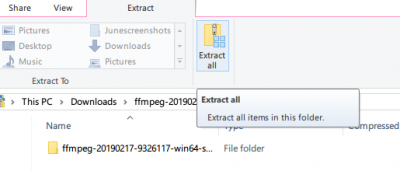
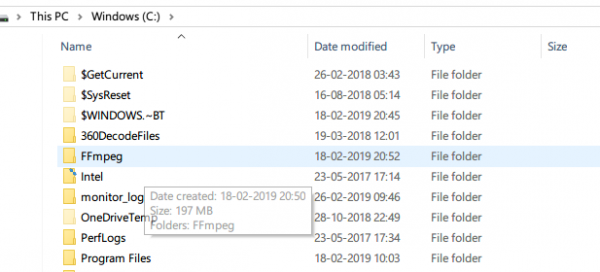
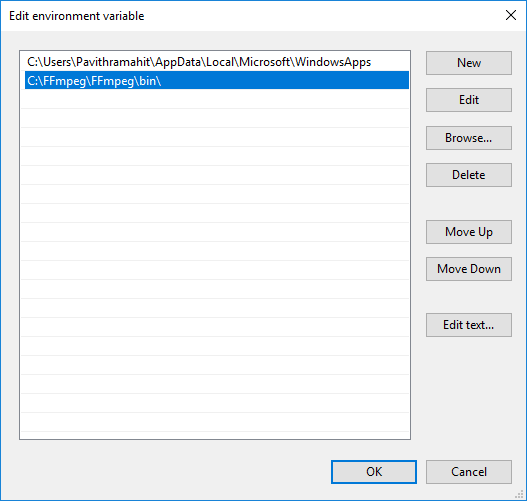
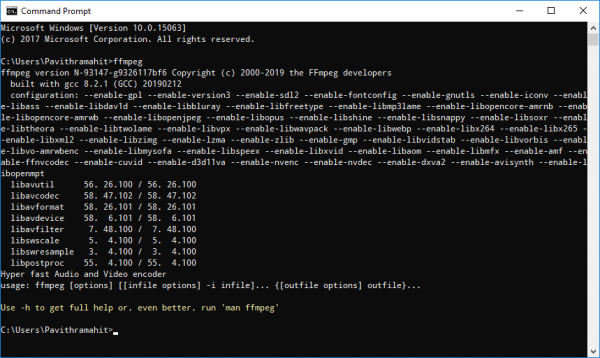




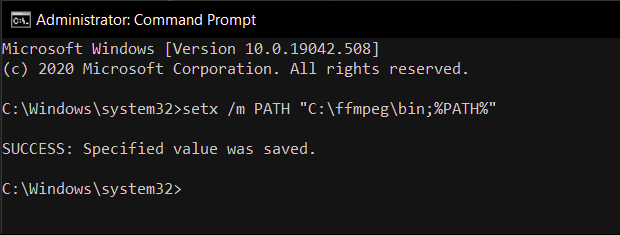
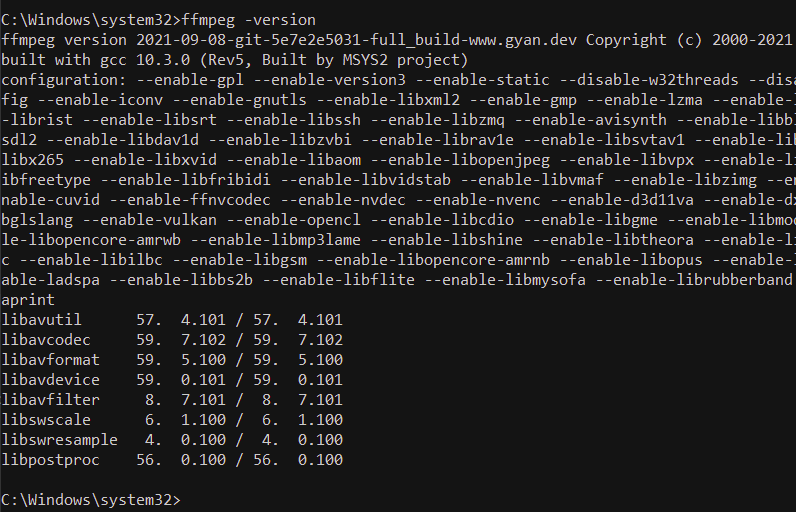
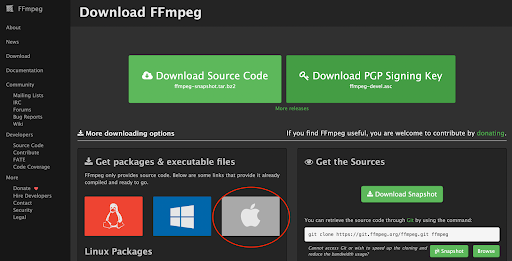
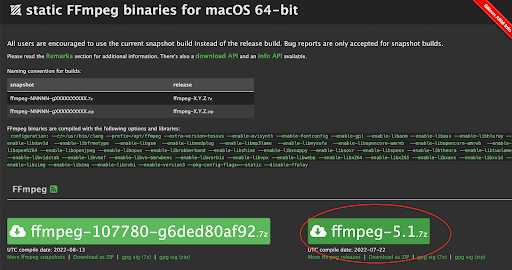
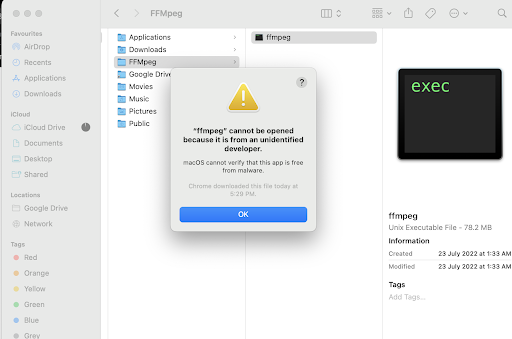






















![Select ‘Path’ under the User variables for [username] column by left-clicking on it. Post selection, click on Edit](https://techcult.com/wp-content/uploads/2020/04/Select-%E2%80%98Path%E2%80%99-under-the-User-variables-for-username-column-by-left-clicking-on-it.-Post-selection-click-on-Edit.png)








